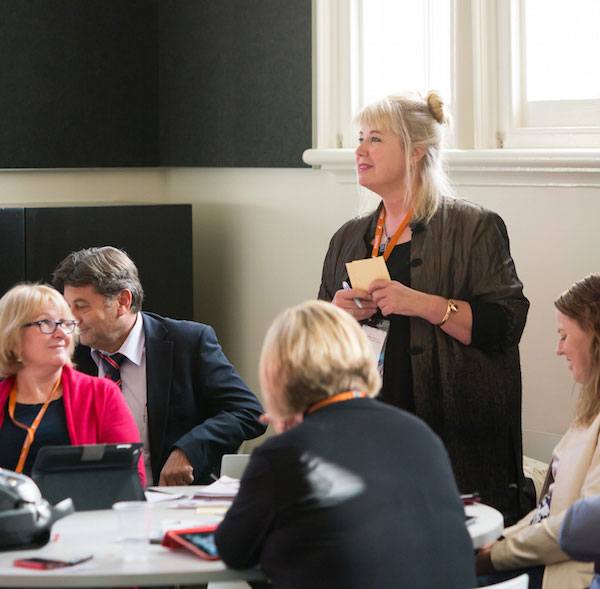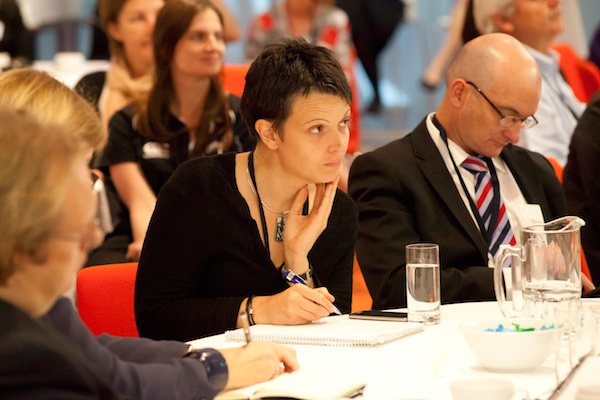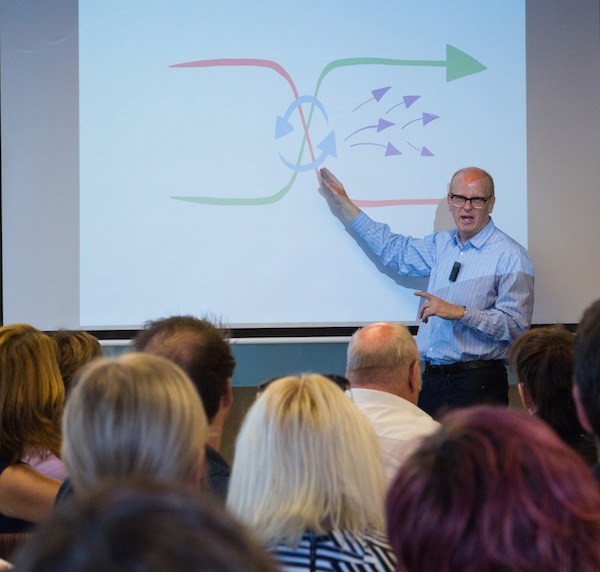
Networking for social purpose: what’s needed?
Networking and collaboration are increasingly important for achieving social change. SVA’s successful model – in education – points to the core elements needed for growing an effective network.

- Individual organisations can make a difference in their communities but by working together in a network, they can spread collective learning more quickly and help build capacity.
- SVA’s Bright Spots Schools Connection is a networking model that has successfully engaged school leaders and started to spread effective practice across participating organisations.
- The common conditions in this networking model relate to participants’ intention, their commitment to the quality of professional relationships they develop, the co-design of activities, and the independence and multi-skills of the convenor.

Networking and collaboration are becoming increasingly important for addressing the complex challenges in many social sectors – to help build capacity and create momentum for change.
Since 2014, SVA has convened a network of schools in disadvantaged communities to share and collaborate to improve teaching practice. The SVA Bright Spots Schools Connection (the Connection) began with eight schools and by 2015 involved 26 primary and secondary schools drawn from three Australian states. SVA plans to extend the network to 40 schools in 2017.
From the evaluation so far, the Connection model has been successful at engaging school leaders. It has taught us a lot about what works in designing effective networking and how networking can diffuse effective practice across participating organisations.
Here we outline the conditions that have been essential for the Connection to succeed. These conditions may well be relevant for other networks with a shared purpose.
The conditions
So what are the conditions needed for networking and collaboration to work?
1. Participation in the network is endorsed by the systems or authorities
In the Connection, the education authority’s or ‘system’s’ endorsement of a school’s participation is a pre-requisite – either the government departments in New South Wales, South Australia and Victoria or the Catholic Education Diocese in Melbourne, Victoria.
It also communicates a broader responsibility and obligation to share with other schools…
This system endorsement provides impetus for leaders to prototype, innovate and explore practice and gives schools greater confidence to act. It also communicates a broader responsibility and obligation to share with other schools beyond the network and to spread the learnings with authority.
2. The participants have a clear (moral) purpose with intention to act

Improving the outcomes in disadvantaged schools is the core impetus that brings participants together in the Connection. Each school that joins the network shares that commitment.
In the words of one participant, “It has attracted like-minded people: I don’t need to argue the case for change. The schools are all open and willing to look at new ideas. Outside of the Connection, it’s hard for me to find such schools, and then put the structures in place to work with them.”
The shared goal connects participants. As one leader said: “It’s wonderful to see everyone approaching the same goal in very different ways. Building connections with other schools improves and builds upon the work that we are doing in our own school.”
3. The participants have a commitment to develop transparent and trusting professional relationships
This commitment cultivates a robust platform for mutual trust and engagement to share and learn. There needs to be a willingness to be challenged and to learn amongst participants; to know that your way isn’t necessarily the best. Each school agrees to contribute and respect each school’s journey. The group cannot be competitive.
They have acted as a critical friend.
“Our connections provide the opportunity for deep conversations and the sharing of great practice,” said a South Australian school leader.
More than just a network, the Connection has become a professional support group for like-minded educational experts.
“As our relationships have developed,” said another NSW school leader, “I have a strong collegial respect for each of the principals and there has been more than one occasion where I have sought advice, counsel and discussions about an idea. They have acted as a critical friend.”
4. Rigorous due diligence processes to select participants that reflect a variety of experiences and competencies
Each school is selected carefully. All are located in a low socioeconomic status school community and have a strong and proven desire to deliver high quality, education opportunities in their communities.[1]
They all come to the Connection with a variety of challenges to solve and expertise to share. The value of the collective expertise within the cohort is the value-add proposition and incentive for the schools to participate.
The Connection uses the National School Improvement Tool (NSIT) which outlines nine domains of school improvement practice. Distributed leadership is a core domain so engagement of the leadership team beyond the principal is mandatory.

… it has really helped to both challenge and sharpen their thinking…
The result as one school leader shared is that, “we have grown as an executive team because we have all had the opportunity to participate, grow, be challenged and then also bring something back to our team.”
Including schools that are already accomplished with schools that are at various stages in the school improvement journey ensures a broad and professionally rich range of questions, insights and expertise. It also helps create a culture with high expectations.
“It has been a fantastic opportunity for school leadership, teaching staff and students to engage in professional learning conversations with staff from other sites. For leadership in particular, it has really helped to both challenge and sharpen their thinking around school structures, directions, focuses and initiatives,” said one teacher.
5. Co-design of structured activities using a strengths-based approach

Structured activities in the Connection include four, two-day ‘thought leadership’ gatherings around set themes, 12 ‘hub’ meetings of local schools around specific topics, and multiple visits to schools each year. The events are co-designed by the convenor with education leaders from the schools and systems. All are optional.
Co-design honours the group’s professional expertise and allows activities to best meet the group’s needs at a given point in time. The strengths-based approach – showcasing and acknowledging the effective work in participating schools – builds confidence in participants to take informed risks, to explore new challenges, and to act.
The professional learning conversations that took place were incredibly rigorous and certainly challenged existing thinking and beliefs.
One school leader said: “The opportunity to hear from others around their projects and where they are heading is great. Being able to test some of your ideas with colleagues who are doing amazing stuff is a great learning experience.”
The school visits enable rich learning and exchange. Another school teacher described: “We had two teachers from another school visit us over two days. The professional learning conversations that took place were incredibly rigorous and certainly challenged existing thinking and beliefs! The teachers gained a lot from the conversations and are really keen to give the work a go back at their own sites.”
Engagement in the events are not mandated as this would undermine the professional trust and respect developed in the cohort. However, most activities are fully subscribed.
6. An independent and multi-skilled convenor with a national view

The Connection is convened and curated by SVA, an independent organisation.
The convenor’s role is to lead the network design, leverage opportunities, manage the dynamics of networking, coach participants, and introduce new ideas, including from outside traditional education practice.
As the Connection’s mandate is to effect change across the country, the convenor’s national perspective is critical. It enables it to connect ideas, resources and expertise across states, sectors and broader systems and from outside the traditional education community.
This feeds the network with new thinking keeping the professional practice content fresh and dynamic for participants.

It also reduces isolation for school leaders and promotes shared responsibility for improving educational opportunities outside the education sector.
The convening body must have credibility and networks…
The convenor needs to have enough expertise in the area, and familiarity with the participants to identify and introduce concepts and resources aligned with, and beneficial for, the network.
The convening body must have credibility and networks, and be able to influence the authorities or systems. This requires being independent but sufficiently aligned with, and trusted by, those systems.
The convenor also needs to have the capacity to connect people, translate ideas and practice across and within systems as well as to coach and mentor participants.
Empowering and enabling culture as a result
These conditions have resulted in a network that empowers, fosters a learning culture and enables its members to achieve the network’s goals.
They provide the best environment for participants to be provoked and stretched in their practices and approaches. These conditions also affirm existing professional expertise and help to grow participants’ confidence and sense of agency.
“The Connection validates what we’re doing. It adds a layer of information and allows us to collaborate and step outside the system,” said one NSW school leader. “It’s accelerated our upward trajectory.”
Sharing collective experience
Hume Central College and Broadmeadows Primary in Victoria have a lot in common. Broadmeadows is an Australian leader in teaching and learning practice based on brain-based metacognition, helping young students to develop self-awareness and executive function to improve learning.
Hume Central College in the same neighbourhood is a successful ‘turnaround’ school, lifting its performance consistently over the past few years. Hume Central College has developed expertise in social emotional learning complimentary to Broadmeadows’ expertise in executive function practices.
The Connection helped the two schools to share expertise, build trust and understand commonalities. In 2016, they partnered to share their collective expertise with 12 other schools in the local neighbourhood.
… they have developed and started diffusing their collective learning faster and more powerfully across the education systems.
The power of networking
These six conditions combined have enabled Connection participants to network and collaborate to achieve their goal: improved education practice. The resultant network culture has allowed school leaders to build capacity together more intentionally and efficiently to improve teaching and learning.
Individually these schools can make a difference in their communities but by working together in a network, they have developed and started diffusing their collective learning faster and more powerfully across the education systems.
Not all of these conditions will apply to other networks. However, we hope that in sharing this experience it promotes more effective networking in other sectors and the spread of practices which have greater social impact.
Author: Sue Cridge
[1] With an index of community socio-educational advantage (ICSEA) below 1000, the average ICSEA value.






